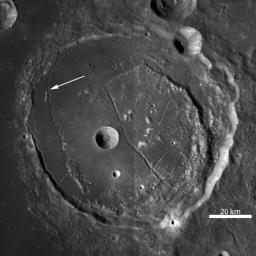
|
Rimae Posidonius
- Click the image above for a larger view
- Full-Res JPEG (1200 x 1200) (201.1 kB)
- Full-Res TIFF (1200 x 1200) (1.4 MB)
Caption:
Spanning over 130 kilometers (81 miles) in length, Rimae Posidonius is a sinuous rille winding across the floor of Posidonius crater. LROC WAC mosaic at 100 meters/pixel (328 feet/pixel), arrow points to the rille and location of an LROC NAC close-up.
Sinuous rilles are remarkable features resulting from turbulent flow of low viscosity (very fluid), high temperature lavas that erodes the pre-existing surface. In turbulent fluid flows, eddies and vortices form that can be highly erosive and result in the twists and turns seen in many rilles. This rille, located on the western edge of Posidonius crater (~100 kilometers, or ~62 miles, diameter, floor-fractured and partially mare-filled), tightly winds against the northern crater wall and then veers away in a southerly course.
Background Info:
NASA's Goddard Space Flight Center built and manages the mission for the Exploration Systems Mission Directorate at NASA Headquarters in Washington. The Lunar Reconnaissance Orbiter Camera was designed to acquire data for landing site certification and to conduct polar illumination studies and global mapping. Operated by Arizona State University, LROC consists of a pair of narrow-angle cameras (NAC) and a single wide-angle camera (WAC). The mission is expected to return over 70 terabytes of image data.
Cataloging Keywords:
| Name | Value | Additional Values |
|---|---|---|
| Target | Moon | |
| System | Earth | |
| Target Type | Satellite | |
| Mission | Lunar Reconnaissance Orbiter (LRO) | |
| Instrument Host | Lunar Reconnaissance Orbiter | |
| Host Type | Orbiter | |
| Instrument | Lunar Reconnaissance Orbiter Camera (WAC) | |
| Detector | Narrow Angle Camera (NAC), Wide Angle Camera (WAC) | |
| Extra Keywords | Crater, Grayscale | |
| Acquisition Date | ||
| Release Date | 2010-12-01 | |
| Date in Caption | ||
| Image Credit | NASA/GSFC/Arizona State University | |
| Source | photojournal.jpl.nasa.gov/catalog/PIA13687 | |
| Identifier | PIA13687 | |
